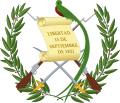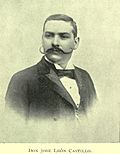| ||||||||||||||||||||
| ||||||||||||||||||||
| ||||||||||||||||||||
| This article is part of a series on |
| Politics of Guatemala |
|---|
 |
Presidential elections were held in Guatemala during seven days in September 1898. [1] Prior to the elections Manuel Estrada Cabrera had established the first real political party in the country's history by admitting people from outside the influential liberals to the Liberal Party. [2]
Contents
The elections were regarded as fraudulent; constitutional guarantees had been suspended for a month and opposition candidate José León Castillo had been unable to campaign. Estrada was declared the winner with 99.8% of the vote, [3] although the number of votes cast is estimated to have been at least three times the number of people eligible to vote at the time. [4] Legislative Assembly Decree 413 of 26 September declared that Estrada's term of office would begin on 15 March 1899, but he assumed the presidency on 2 October. [3]

